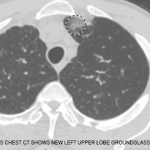 There is an old adage that there are two types of people—lumpers and splitters. For some, people are easily categorized into liberal vs. conservative, Democrat vs. Republican, Donald Trump supporter vs. Hillary Clinton supporter. For others, everyone is a snowflake, and what makes us different is much more important than what makes us the same. So a splitter would look at a room full of Trump supporters and not see a room full of Trump supporters. Instead, a splitter might see a few single-issue voters mingling with anti-NAFTA voters, anti-Clinton voters, anti-establishment voters and a handful of people who are just tired of not being cut a break.
There is an old adage that there are two types of people—lumpers and splitters. For some, people are easily categorized into liberal vs. conservative, Democrat vs. Republican, Donald Trump supporter vs. Hillary Clinton supporter. For others, everyone is a snowflake, and what makes us different is much more important than what makes us the same. So a splitter would look at a room full of Trump supporters and not see a room full of Trump supporters. Instead, a splitter might see a few single-issue voters mingling with anti-NAFTA voters, anti-Clinton voters, anti-establishment voters and a handful of people who are just tired of not being cut a break.
When I was an undergraduate, I—along with every other pre-med on campus—enrolled in Chem 10, the introductory chemistry course, which was taught by Dudley Herschbach. If you were a chemist, you would know that he was a Nobel laureate, having won the Nobel Prize in Chemistry in 1986, along with Yuan T. Lee and John C. Polanyl, for having developed the field of molecular stereodynamics. If you were a freshman, however, you knew Dr. Herschbach as an affable, grandfatherly chemistry professor. He was the professor who let you play your music over the auditorium loudspeaker before class started as a reward for getting up extra early. He also bemusedly tolerated students nodding off, knowing that at that age, an 8 a.m. class may as well have been held at the crack of dawn.
On the day of his last lecture, trying to convince us to join the ranks of chemistry majors, he told us why chemistry was superior to the other sciences. Life, he said, was like an impressionist painting. Physicists stand too close to the painting; all they see are the dots. Biologists are too far away; they can make out the boats and the churches, but cannot see what makes them special and unique. It is the chemists, he said, who have the right perspective and can see the whole picture.
Of course, that is a matter of perspective, as well; some people like the dots, and you can easily picture a professor of physics waxing poetic on their intricacies and charms.
Those of you who have had the misfortune of sitting through one of my talks on vasculitis know that I am a lumper. Severe granulomatosis with polyangiitis should be treated with cyclophosphamide or rituximab. Non-severe granulomatosis with polyangiitis should be treated with methotrexate.
In truth, however, I am a secret splitter. I use rituximab for the treatment of severe granulomatosis with polyangiitis, except in patients with rapidly progressive glomerulonephritis, when you can see the serum creatinine increase a full point every other day. Rituximab may be used for severe granulomatosis with polyangiitis, but it really shines as a treatment for patients with so-called grumbling disease, who have never been able to make it all the way off of prednisone. Methotrexate should be used for the treatment of non-severe vasculitis, except when there is even a hint of kidney involvement, because those patients are at even higher risk of renal relapse than other patients with limited disease.
And so on. When I teach, I lump, because I have no choice. There aren’t enough PowerPoint slides in the world to capture every nuance, so I round off the sharp corners and apply a little English to nudge a wanton fact into place. When I am in clinic, however, I split, and I compare each patient to the Roladex of patients I carry in my head, to see if I can find some clue to what might happen next.
Different Split
In 1956, rheumatologists began to split the inflammatory arthritides. That was the year that five members of the American Rheumatism Association reviewed 322 cases provided by physicians in 19 cities in the U.S. and Canada, and emerged with the American Rheumatism Association diagnostic criteria for rheumatoid arthritis.1 These criteria were gradually honed in a series of revisions, taking into account the discovery of rheumatoid factor and the importance of distinguishing rheumatoid arthritis from other diseases, such as the spondyloarthropathies, the crystalline arthropathies, polymyalgia rheumatica and other diagnoses that had gradually become more evident.2
In 2010, a sea change took place. A working group, comprising members of the ACR and the European League Against Rheumatism (EULAR), met to develop a new approach to the classification of rheumatoid arthritis. They noted that prior criteria “have a significant limitation in that they were derived by trying to discriminate patients with established RA from those with a combination of other definite rheumatologic diagnoses. They are therefore not helpful in achieving the goal of identifying patients who would benefit from early effective intervention. … Indeed, with modern therapies, the goal is to prevent individuals from reaching the chronic, erosive disease state that is exemplified in the 1987 criteria for RA.”3
That, in a nutshell, was the impetus for change. Gone were the days when rheumatologists were bystanders, content to simply catalog patients as the disease took its course. Effective therapeutics caused us to set our eyes higher, toward earlier and more aggressive therapies that may minimize damage, or even halt the cycle of inflammation before damage could take place.
Advances in the treatment of rheumatoid arthritis were quickly followed by advances in the treatment of other rheumatic diseases, and with these successes came a need to identify patients at ever-earlier stages of disease, when they may benefit most from our interventions. Thus came a parade of new scoring systems, with their progressively more complex methods of discerning who may be a good target for clinical trials in systemic lupus erythematosus, Sjögren’s syndrome, scleroderma, inflammatory myopathies and other diagnoses that are so desperately in need of therapeutic advances.
This search for the perfect criteria shows no evidence of slowing down. There is an ongoing, multinational effort to revise the way we classify the systemic vasculitides. The classification criteria for both systemic lupus erythematosus and Sjögren’s syndrome are already being re-revised. Given the grumblings about the new scleroderma classification criteria, which still fail to capture all patients that we would like to enroll in clinical trials of systemic sclerosis, I would not be surprised if these criteria also saw an early death.
Advances in therapeutics from this point forward may depend on lumping patients together based on mechanism rather than clinical features.
Pornography & Other Problems
In 1964, Justice Potter Stewart, opining on the definition of pornography, noted, “I shall not today attempt further to define the kinds of material I understand to be embraced within that shorthand description; and perhaps I could never succeed in intelligibly doing so. But I know it when I see it. …”4
Thus, Justice Stewart captured the state of the art for classification systems in rheumatology. We rely on the opinions of experts. Remarkably little has changed in our approach toward classifying patients since the days of the American Rheumatism Association. Inevitably, we depend on experts to teach us how to lump. Even modern approaches, such as 1000minds, are fueled by expert opinion, albeit many more experts than were previously possible.5
This reflects a central problem with our approach. Lumping patients together based on clinical criteria may not reflect key differences in pathogenesis. On the other hand, we cannot create classification criteria that are so restrictive that we have no patients left to enroll in our studies. Thus, we have become accustomed to clinical trials that use the same drug for all patients with uveitis, regardless of etiology. We have also become accustomed to studies that examine ANCA-associated vasculitis, which is generally translated as “severe granulomatosis with polyangiitis, microscopic polyangiitis and renal-limited vasculitis, but not eosinophilic granulomatosis with polyangiitis,” because we have to include all of these subsets to reach the necessary N.
We do this because we have to. We know that some data are better than no data, so we design clinical trials based on the possible, and we hope that lumping disparate patients together will not muddy the message of the clinical study too much.
This practical approach likely leaves us with lumps that are too big. Using the old criteria for systemic lupus erythematosus, for example, a patient would have to meet four of 11 criteria to be classified as having lupus. You may recall from your high school math class that the notation for the number of combinations that may satisfy that straightforward rule is 11!-7!; this translates into almost 40 million different combinations of signs and lab parameters that could be used as proof of a patient’s worthiness to enroll in a clinical trial of lupus. It is difficult to imagine that a single drug would work for all of these clinical presentations, even if they all carry the same name.
A Better Splitter
The common pathway is the Achilles heel of clinical classification criteria. For every combination of signs and symptoms that is thought to be pathognomonic for a given rheumatic disease, exceptions to the rule exist. These exceptional patients, with their alternate pathogenesis and alternate mechanisms, likely require alternate treatment approaches, as well. Including these patients in our clinical trials, especially in studies of rare diseases, may introduce just enough variation to nudge the P value for the primary endpoint above 0.05.
It is possible that we have simply reached the limits of clinical classification. It may be asking too much from the poor clinician to differentiate patients whose arthritis is mediated by Th17 from patients whose inflammation is predominately a product of defective Treg cells.
Part of the problem may be that, as clinicians, we may not be as smart as we think we are. Clinical classification may be subject to subconscious, cognitive biases, which we think of as clinical intuition, but may actually be clinical mistakes.
This is not a new concept. In 2011, for example, the European Academy of Allergy and Clinical Immunology and the American Academy of Allergy, Asthma & Immunology proposed leaving behind phenotypes in favor of endotypes, which would group patients according to the underlying pathophysiologic mechanism.6
Advances in therapeutics from this point forward may depend on lumping patients together based on mechanism rather than clinical features. In his discussion of juvenile idiopathic arthritis, Peter Nigrovic, MD, proposes two ways forward:
- Genetics: Dr. Nigrovic writes, “If genetics reflects mechanism, then shared genetics is strong prima facie evidence of a common pathophysiology.” Further, it seems logical to assume that patients who share a similar pathophysiology are more likely to respond to the same drug than a patient who reached the same phenotype by another route.
- Big Data: Computers are not subject to cognitive biases, and machine learning may identify clinical insights to which we are blinded. Physicians generally think of evaluating patients clinically to identify a phenotype. With machine learning, the analysis can start with the outcome of interest and then work backward to find the clinical and serologic clues that predict that outcome.
A third route may be to use dynamic, rather than static, criteria for classifying patients. In his work on scleroderma, for example, Colin Ligon demonstrated that serial measurements of forced vital capacity could be used to group patients into three categories, each of which was associated with a different probability of death.7 Working backward, it seems that calcinosis, among other factors, could be used to predict to which group a patient may ultimately belong. Presumably, a deeper meaning connecting calcinosis to lung function exists and is just waiting to be explored and exploited.
We are, of course, constrained by our data, or lack thereof. Our discussions of genetics are still often limited to discussions of HLA subtypes, and a big data approach implies that we have big data, which is only true for the most common rheumatic diseases. Moreover, big data approaches depend crucially on the quality of the data we collect. We cannot analyze tests that we did not think to order. Similarly, applying modern technologies, such as natural language processing, to our hastily written electronic documentation may not be as fruitful as we had once hoped.
Probably the biggest constraint, ironically, is us. If you are like me, you were dragged kicking and screaming into the latest era of classification criteria. The new criteria resist all attempts at mnemonics, because they require that you remember both the criteria and the associated point system that determines whether a patient merits a given diagnosis.
In the next era, it seems likely that patients will be classified on the basis of some combination of clinical features and molecular markers, and we will simply have to get used to the idea that two patients who clinically have the same disease may require very different therapies. The next era of therapeutics will require us to find different ways to lump our patients. As Professor Herschbach might have said, it’s all a matter of perspective. We just have to move a little closer.
 Philip Seo, MD, MHS, is an associate professor of medicine at the Johns Hopkins University School of Medicine, Baltimore. He is director of both the Johns Hopkins Vasculitis Center and the Johns Hopkins Rheumatology Fellowship Program.
Philip Seo, MD, MHS, is an associate professor of medicine at the Johns Hopkins University School of Medicine, Baltimore. He is director of both the Johns Hopkins Vasculitis Center and the Johns Hopkins Rheumatology Fellowship Program.
References
- Ropes MW, Bennett GA, Cobb S, et al. Propsoed diagnostic criteria for rheumatoid arthritis. Bull Rheum Dis. 1956 Dec;7:121–124.
- Arnett FC, Edworthy SM, Bloch DA, et al. The American Rheumatism Association 1987 revised criteria for the classification of rheumatoid arthritis. Arthritis Rheum. 1988 Mar;31(3):315–324.
- Aletaha D, Neogi T, Silman AJ, et al. 2010 Rheumatoid arthritis classification criteria: American College of Rheumatology/European League Against Rheumatism collaborative initiative. Arthritis Rheum. 2010 Sep;62(9):2569–2581.
- Jacobellis v. Ohio. 378 U.S. 184 (1964).
- 1000minds.
- Lötvall J, Akdis CA, Bacharier LB, et al. Asthma endotypes: A new approach to classification of disease entities within the asthma syndrome. J Allergy Clin Immunol. 2011 Feb;127(2):355–360.
- Ligon C, Schulam P, Saria S, et al. Faces in motion: Clinical subtyping in scleroderma using changes in forced vital capacity [abstract 2019]. Arthritis Rheumatol. 2016;68(suppl 10).
Errata
In the article, “Family Practice,” in the March issue of The Rheumatologist, Jonathan Kay, MD, was incorrectly identified as the chief of rheumatology at the University of Massachusetts. However, the chief of rheumatology is Ellen Gravallese, MD, who holds the Myles J. McDonough Chair in Rheumatology at UMass and and is professor of medicine at the University of Massachusetts Medical School.
Also in March, the Rheum After 5 column misidentified the journal for which Joan M. Von Feldt, MD, MSEd, is the editor in chief. She is actually the editor in chief of the Journal of Clinical Rheumatology.
The editors regret these errors.


